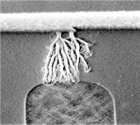Hybrid Semiconductor Material Found For High-temps
Argonne (IL) - A newly published research finding at Argonne National Laboratory has identified a hybrid organic/inorganic material with zero thermal expansion (ZET) that is proving suitable for use in semiconductors. Such ZET products would allow for a much wider operational temperature range, resulting in faster clock rates and higher performing computers.

Traditional ZETs have found uses in optics, heat-engine components and kitchenware. Most of those materials are based on glass, which isn't well suited for semiconductors. However, a newly researched hybrid inorganic-organic material is displaying characteristics of a "multifunctional semiconductor[, one] that has been previously shown to possess superior electronic and optical properties". According to the press release, this new research indicates there may be a way to custom develop a whole class of materials with pretty much any positive or negative thermal expansion values that are required, allowing items to expand, shink, or remain the same size when exposed to heat.
These kinds of hybrid materials will be used in lasers first, as well as ultrathin and flexible solar cells, LEDs and other sensors. Some of these new materials can be doped to allow them to be completely transparent to visible light, making them suitable for future flexible displays as well. These hybrid materials are also exhibiting resilience in open-air applications, where typically such materials break down chemically. Even in the presence of UV light, they retain their electro-chemical properties. The laboratory has tested the materials in open-air for "a few years", and at temperatures up to 200C. According to principal investigator Yong Zhang of National Renewable Energy Laboratory (NREL), "Not only do the crytal structures remain unchanged, but their electronic and optical properties remain after a few years [of such testing], a feature attributed to the strong covalent bonding throughout the structure".
Research work at Argonne was augmented through cooperation with NREL, who initiated the project. Additional contributions came from Rutgers University, who synthesized the materials. Argonne's Advanced Phonton Source division handled critical X-ray diffraction measurements. The University of Arkansas and University of Colorado at Boulder also contributed. Argonne National Labs is managed for the U.S. Department of Energy's Office of Science.
Stay On the Cutting Edge: Get the Tom's Hardware Newsletter
Get Tom's Hardware's best news and in-depth reviews, straight to your inbox.
